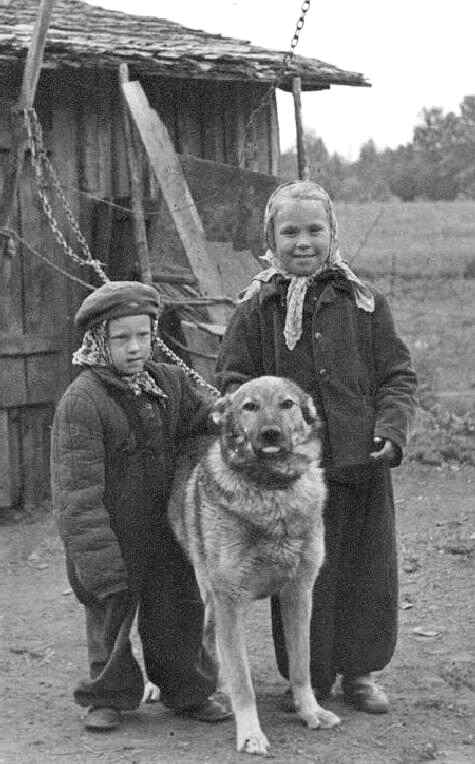
Figure 1.--These unidentified Estonian children are pictured with the famikly guard dog. The photograph is undated, but looks to have been taken after World War II. |

|
We have begun to collect information about the activities in which Estonian boys engaged abd the clothes associated with those activities. School of course was a primary activity. The oldest educational facility in Estonia is the University of Tartu, establisged in 1632. The educational system was heavily influenced by the Soviet system. We note boys without school uniforms right after World War II, but presumably as the country began to recover from the War, the standard Soviet school uniform became more common. Since independence, Estonian school children no longer wear uniforms. I'm unsure just what other changes have taken place in education since independence. One change is there are now schools that operate in the Estonian as well as the Russian language. We also notice youth groups. During the Soviet era the Young Pioneers became essentially manditoruy. Religion was more complicated. Estonian was a largely Protestant country, but the Tsarist Goivernmrent promoted Orthodoxy and the Communists athism. The importance of religion in Estonian life was substantially reduced during the Soviet era. We see some children with pets, but for the most part keeping pets was difficult during the soviet era.
We see some children with pets, but for the most part keeping pets was difficult during the soviet era. This was somewhat easier for Esgtonians living in rural areas. Here we see some rural kids with family pooch.
Religion is somewhat complicated. Estonian was a largely Protestant country, but the Tsarist Governmrent promoted Orthodoxy and the Communists launched an atheism campaign. The importance of religion in Estonian life was substantially reduced during the Soviet era. Those Estonians identifying themselves as religious are mostly Lutheran. Russians are mostly Orthodox. A German reader writes, "I was confirmed in 1949. There were two refugee girls from one of the Baltic countries in our group. I don't remember from which one. [HBC note: We suspect thatvthey were Estonian because Lithuanians are more Catholic, but they could have been Latvian.] They were about 14 yeras old and wanted to be confirmed. The clothing concerned them. They wanted to be vonfirmed in white clothes as was common in there homeland. German girls (as German boys) had to wear black or at least dark clothes (or suits) for confirmation in the (Protestant Luthern) church (opposite to the Catholic church where girls, about 8 years old wear white clothes for First Communion). Our Church community made an exemption for them. It was a moving experience for us all."
We notice a number of outings in which Estonian children participate. This incluses both small groups and larger mostly family groups. This includes urban parts as well as country outings. We do not yet know anything about Estonian parks. This often meant visits to the grand parents. Some photigraphs we have found look to us like family reunions, but unless there is some writing on the back this is difficult to determine. A problem with outings is transport. Few Estinian families had cars, at least until the country was able to exit the Siviet Union (1991). hus it was difficult ti get out into the country. Basically people would take trains to poular spots and then be on foot from there.
The oldest educational facility in Estonia is the University of Tartu, establisged in 1632. The educational system was heavily influenced by the Soviet system. We note boys without school uniforms right after World War II, but presumably as the country began to recover from the War, the standard Soviet school uniform became more common. Since independence, Estonian school children no longer wear uniforms. I'm unsure just what other changes have taken place in education since independence. One change is there are now schools that operate in the Estonian as well as the Russian language.
We have little information on Estonian youth groups at this time. Scouting began tp appear in informally in Estonia while the country was still part of Tsarist Russia. Theearliest reported activites are note a few years before World War I (1912). I know of no other youth groups in Estonia at the time. After the World War I as Estonia fought for its independence from the the Bolsheviks, the Eesti Skautide Ühing (Estonian Scout Association) was formed (1919). The Estonian Scout Association was one of the founding members of the World Scout Organization (1922). Scouting was popular in Estonia during the inter-war years, but we have few details at this time. The Soviet Union occypied Estonia (1940) and banned Scouting. Any attempt to participate surepticiously in Scouting was dangerous as the Soviets view it as a Fascist organization and counter-revolutionary. I am not sure to what extent the Soviet Pioneer movement was organized in Estonia pripr to the NAZI invasion. The NAZIs invaded the Soviet Union (June 1941) and within weeks reached Estonia (July). I do not know if the NAZIs attempted to organize any nationalist youth group. The Red Army retook Estonia (1944) and for several decades the only youth group allowed to function was the Young Pioneers. The Eesti Skautide Ühing was reformed (1989) as Estonia began to move toward independence.
Related Chronolgy Pages in the Boys' Historical Web Site
[The 1880s]
[The 1890s]
[The 1900s]
[The 1910s]
[The 1920s]
[The 1930s]
[The 1940s]
[The 1930s]
[The 1940s]
[The 1950s]
[The 1960s]
[The 1970s]
[The 1980s]
Related Style Pages in the Boys' Historical Web Site
[Smocks]
[Long pants suits]
[Knicker suits]
[Short pants suits]
[Socks]
[Eton suits]
[Jacket and trousers]
[Trouser suspension]
[Blazer]
[School sandals]
[School smocks]
[Sailor suits]
[Pinafores]
[Long stockings]
Navigate the Boys' Historical Clothing Web Page
[Return to the Main Estonian country page]
[Introduction]
[Activities]
[Biographies]
[Chronology]
[Clothing styles]
[Countries]
[Bibliographies]
[Contributions]
[FAQs]
[Glossaries]
[Images]
[Links]
[Registration]
[Tools]
[Boys' Clothing Home]
